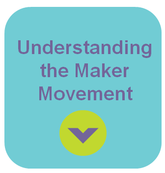By: Melissa Hughes, Ph.D. on January 6th, 2015
5 Ways to Improve Teaching with Brain-Based Research
Featured Topics: Industry News and Trends | Featured Topics: Professional Development
Republished with permission from Melissa Hughes, Ph.D. Original article posted on December 2, 2014
 There has been a lot of buzz lately around the maker movement. Recent brain-based research support the notion that hands-on making, building, and creating not only nurture creativity, but also impact cognition, working memory, and innovative problem solving. While we don’t have to have the working knowledge of neuroscientists, if we're going to improve our practice of teaching it's important to understand how the brain learns.
There has been a lot of buzz lately around the maker movement. Recent brain-based research support the notion that hands-on making, building, and creating not only nurture creativity, but also impact cognition, working memory, and innovative problem solving. While we don’t have to have the working knowledge of neuroscientists, if we're going to improve our practice of teaching it's important to understand how the brain learns.
And if we want to nurture creativity, it’s important to understand that creative thinking involves communication among brain regions that do not normally interact with one another. Most brain-based researchers will agree that there is not one single brain area responsible for creativity. Therefore, nurturing creativity requires stimulating multiple parts of the brain.
Learning creates neural pathways in the brain that get stronger with practice. The combination of creative thinking and learning results from the generation of ideas (in the frontal lobe) combined with emotions, meaning, and memory (in the temporal lobe) and the release of dopamine, a neurotransmitter that sends signals to engage other nerve cells in the brain.
Until recently, many psychologists identified creativity as a fixed trait – you were either creative or you weren’t. We now know that creativity is hardwired into our brains – we either tap into it, nurture it, and develop it or we don’t. Ask 25 kindergartners how many of them are artists, and you'll see 25 hands in the air. While most young children will easily classify themselves as “creative,” that number drops to 50% in fifth grade, and plummets to 10% in high school. The reasons for the dramatic shift are both scientific and emotional.
The biological explanation is that the emotional brain is fully functional by about age 12. But the prefrontal cortex (the region that controls executive functions such as complex cognitive behavior, decision making, and social control) doesn’t fully mature until one has reached his mid-twenties. So, in the early grades, students create with relative freedom. The purple cow is deemed creative and imaginative. In fifth grade, the prefrontal cortex is showing signs of development in the form of inhibitions. Students begin to moderate their behavior based upon judgment from others. By high school, students are very much aware of how others view their work and most of their academic experiences have centered around “the right answer” rather than innovative thinking. Purple cows no longer exist and we begin to associate being "wrong" with a penalty or consequence. Our prefrontal cortex trumps risk-free learning and exploration.
So how do we promote healthy development of the prefrontal cortex without squashing the creativity along the way? Here are five strategies that can help you improve teaching with brain-based research in mind:
Provide creative constraints.
When you tell learners of any age to “be creative” without guidelines, you'll likely see more than a few "deer in the headlights" looks. Too much freedom can actually have the opposite effect. For example, rather than asking students to create an invention, ask them to create an invention that includes three wheels and a pulley. Or write a creative story that includes a boy, a dog, and a kite. A few restrictions or guidelines can often stimulate more ideas and generate better results.
Challenge the brain with divergent thinking.
We're trained to think about teaching and learning in terms of convergent thinking. Follow a specific set of steps to arrive at a single correct answer. In contrast, divergent thinking is a process used to generate many possible solutions. Divergent thinking processes require the brain to search through the “archives” for as many stored ideas, data points, and related facts that could generate more possible solutions. This kind of thinking actually stimulates more areas of the brain and allows for more neural connections.
Focus on ideas.
A creative learning environment will allow students to focus on ideas rather than facts. Yes, they need to know certain facts, but when students learn how to recognize conceptual relationships, they will be better able to apply known facts to new ideas.
Make creativity a habit.
Creative thinking requires generating “out of the box” ideas which is contrary to the brain’s preference for patterns, logic, and meaning. By encouraging creative expression, students will become more and more comfortable thinking of new possibilities rather than rely on established patterns of thinking.
Model risk-free creativity.
If you want your students to be creative makers, it’s important for them to see it in action. Build, create, paint, and step out of your own box, and demonstrate that creativity doesn’t come with a guide and doesn’t have one right answer. When your students realize that “making” is just one way to transform an idea into something real and tangible, they’ll become more comfortable with the process and learn how to nurture their own ideas.
Teachers who want to create a classroom climate conducive to innovative thinking and problem solving look for ways to help students connect the content with how they see the content, think about it and feel about it. So the next time you plan a creative assignment, ask yourself how many parts of the brain that assignment engages.
References
Libow Martinez, Sylvia & Stager, Gary. (2013). Invent to Learn. Constructing Modern Knowledge Press, Torrence, CA.
Jensen, Eric. (2006) Enriching the Brain. Jossey-Bass/Wiley, San Francisco, CA.
Drapeau, Patti. (2014) Sparking Student Creativity. Association for Supervision and Curriculum Development, Alexandria, VA.
Sousa, David. (2013) From STEM to STEAM. Corwin, Thousand Oaks, CA.
 Melissa Hughes is the founder of The Andrick Group. In her own words: My experience in education, publishing, and marketing communication has provided me with a very unique skill set - one that has enabled me to do what I love and love what I do. Education is simply in my DNA, and I get to work with great educators all over the country. In addition to that, I'm fortunate to be able to put my marketing and strategic skills to work in other areas, too.
Melissa Hughes is the founder of The Andrick Group. In her own words: My experience in education, publishing, and marketing communication has provided me with a very unique skill set - one that has enabled me to do what I love and love what I do. Education is simply in my DNA, and I get to work with great educators all over the country. In addition to that, I'm fortunate to be able to put my marketing and strategic skills to work in other areas, too.


